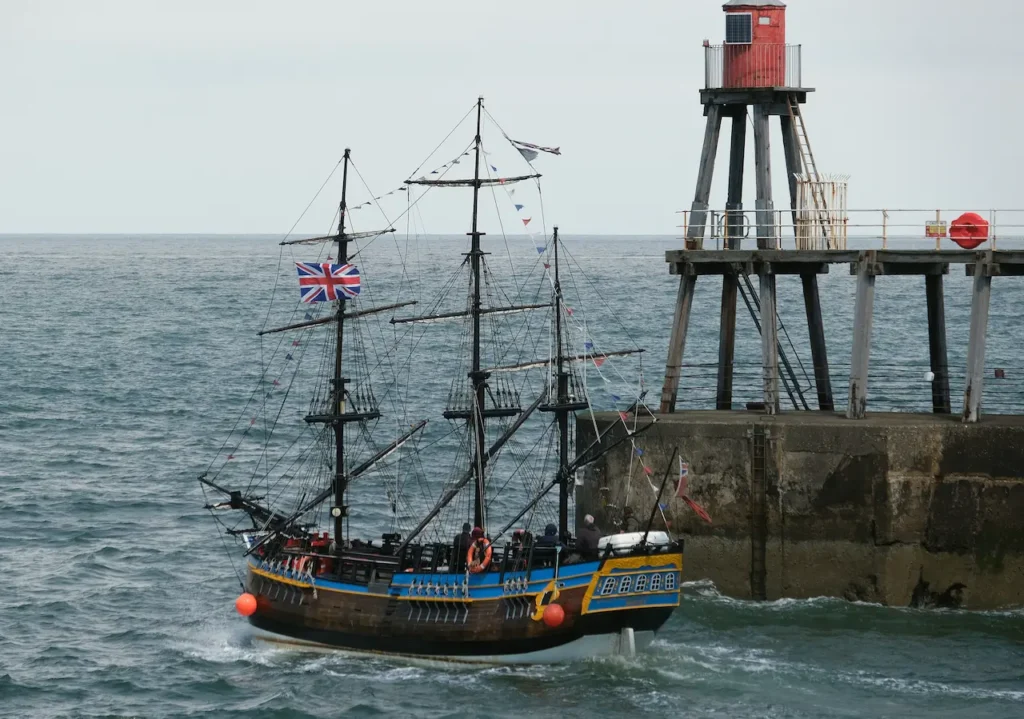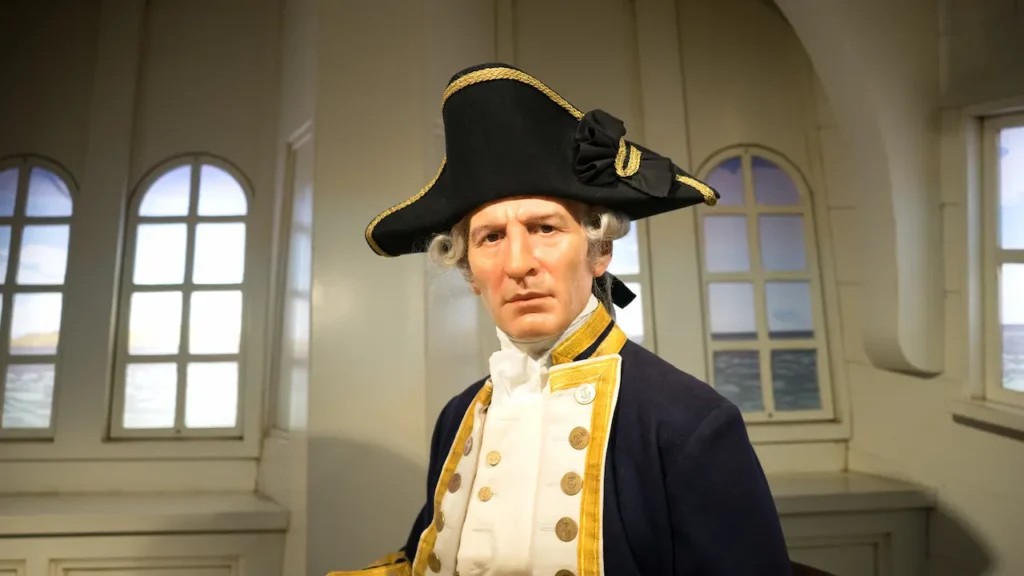The Captain Cook’s Endeavour
Captain Cook was a humble farm boy who grew up to become one of the most famous navigators, explorers, and cartographers of the Enlightenment. Cook, who was born on October 27, 1728, to a Yorkshire girl and a Scottish worker, was a hard-working, bright student. Cook left school when he was 16 years old, became an apprentice seaman at age 18 and then joined the navy nine years later.
Captain Cook led an expedition to the South Seas in 1768 to observe Venus’ transit across the Sun. On board was naturalist Joseph Banks.
Cook, after completing his observations in Tahiti and claiming the land for England, issued secret orders to travel southwards. Cook landed in New Holland, Australia, after charting parts of New Zealand. He made contact with Aboriginals and mapped the east coast. After a brief shipwreck on the Great Barrier Reef, he continued north and west, completing the first of two global circumnavigations.
He again went in search of the Unknown Southern Land. In 1772-1775, he spent a lot of time sailing in the southern high latitudes and fighting storms and pack ice. He was within 150 miles of Antarctica, but never saw it.

Cook stopped at Adventure Bay in Tasmania’s Bruny Island on his third voyage. He had sailed first to the South Seas and then up to the Pacific Coasts of North America, Siberia, and Alaska. Cook was killed in Hawaii on 14 February 1779, during a fight between his crew members and locals. He had stopped at the Sandwich Islands while returning to England by Cape Horn. Four powerful Hawaiian chiefs ate his heart in an honour ceremony, believed to show how highly regarded the Hawaiians were.
The First Voyage of Captain Cook
The Admiralty, the Royal Society, and Captain James Cook were responsible for the most important voyage of exploration in British history. Cook was forty years old and was given the task of leading the expedition.
Three months after he took command of the HM Bark Endeavour on 25 August 1768, he led his ship out of Plymouth Harbour. He was headed for Tahiti to set up an observatory there to record the transit between Venus and the sun on 3 June 1769. Cook’s unspoken goal was to claim the “great south land” for Britain.
Captain Cook headed south after observing the Transit of Venus. Cook, after sailing up the west side of New Zealand and proving it was not part of the large southern continent as Dutch explorer Abel Tasman proposed, then sailed to the west, reaching the southern coasts of New South Wales by April 1770.
Then he sailed to the north and charted the eastern coast of Australia.
Cook kept a log of his experiences and discoveries during the voyage. He sent copies to the Admiralty at different ports, upon their request, in order to report on the progress of the expedition. It is fascinating to read his account.
On 22 August 1770, Captain Cook completed his secret mission by claiming the land at Possession Island for Great Britain. The mythic significance of the Great South Land was so great that people speculated about its size and extent even after Cook’s journey.
Cook’s Triumph Overshadowed the Fate of Endeavour
Captain James Cook was celebrated as a hero in Britain when he returned from his pioneering voyage to the Pacific Ocean. He had charted unknown lands and observed the transit of Venus. His journey also expanded the British Empire’s understanding of the Pacific. Cook’s name was etched into history, but his ship, HMS Endeavour, faded away.
The once-famous ship was laid up in Woolwich Dockyard shortly after its return. She was refitted as a modest naval transport and storage ship. Endeavour, stripped of her glory and repurposed as a humble naval transport and store ship, spent several years ferrying personnel and goods between Britain and remote islands such as the Falklands. In 1775, her timbers were aging, and her fame had been forgotten. She was sold by the Royal Navy to the London shipping firm Mather & Co for a modest sum of PS645. Many assumed that she would then be scrapped.
But fate had a different plan for her. In 1775, the American Revolutionary War erupted, and Endeavour had to be pressed into service with a new name. In 1775, she was renamed Lord Sandwich and conscripted to the British military effort. She was part of a fleet that invaded New York and was stationed there during the Battle of Long Island in 1776. This battle secured British control of New York.

As the war progressed, the HMS Sandwich was transformed into a prison ship in Newport, Rhode Island. The prisoners were kept in these floating prisons, often under harsh and deadly conditions. The British destroyed several ships in August 1778 to prevent the French-Americans from landing in Newport. This included Lord Sandwich. Her remains are still found in the mud at Newport Harbour.
Her fate was a mystery for centuries. In the 1990s, after years of meticulous research into archival records, the connection between Endeavour and Lord Sandwich became apparent. The discovery was made by maritime archaeologists, historians, and naval documents. They also examined physical evidence. Cook’s Endeavour, they discovered, had not fallen into the void of time, but was buried beneath the waters off Newport. Divers continue to explore the site today, trying to piece together the last chapter of one of history’s most iconic expedition vessels.
The H.M. Barge Endeavour
H.M. Bark Endeavour, the famous ship of Captain James Cook, was built in humble beginnings. Bark Endeavour shared humble beginnings with other vessels in her time. She was built in 1764 by Whitby shipbuilder Thomas Fishburn and originally called the Earl Pembroke. She is classified as a Whitby cat or collier. These flat-bottomed, sturdy ships were built to transport heavy coal loads from the North East of England to London. They could easily navigate the shallow coastal waters.
The Royal Society was looking for a vessel in 1768 to conduct a crucial scientific mission into the Pacific Ocean. They wanted to observe the transit of Venus across the sun’s face, a phenomenon predicted many years before by Edmund Halley, whose name is still associated with Halley’s Comet. This observation was crucial to astronomers in calculating the distance between Earth’s surface and the Sun, which is a key step for understanding the size of the solar system. The Admiralty bought the Earl Pembroke with the help of King George III, who provided royal funding for the venture. This was a modest amount for a ship that would make history.
The vessel was brought to Deptford Dockyard in London, where it was extensively refitted for ocean voyages over long distances. The modifications included strengthening the hull to withstand tropical seas, adding workspaces for scientists and cabins, and equipping it with additional provisions. She was renamed H.M. Bark Endeavour, symbolising the spirit of British exploration and scientific curiosity.
The Admiralty chose Captain James Cook to lead the expedition. At that time, Cook was a relatively unknown navigator and cartographer who had a high level of skill. In August 1768, Endeavour set off from Plymouth on a journey that would change the world. After nearly a year at sea, Endeavour rounded Cape Horn and arrived in Tahiti. Cook’s team recorded the Venus transit even though one of their crucial scientific instruments, a quadrant, was stolen by islanders and later returned.
Endeavour, after the Tahiti expedition, continued its voyage of discovery. She spent six months carefully charting and mapping the coasts and islands of New Zealand, becoming the first European ship to do so. Cook landed on the east coast of Australia, at a location he called Botany Bay. He claimed possession of Eastern Australia under the name New South Wales.

Endeavour Almost Didn’t Make it Back to Britain.
Endeavour’s first circumnavigation, under Captain James Cook, is celebrated as a great voyage in history. However, the ship’s miraculous survival has been praised. Endeavour left Portsmouth in 1768 and sailed across the Atlantic from Rio de Janeiro to Funchal, in the Madeira Islands. She sailed around Cape Horn and into the Pacific. After stopping in Tahiti for the transit of Venus, she charted countless islands, claiming them as British. In 1770, Cook made her most famous landing when she reached Australia’s east coast. She was the first European to record the coastline.
The voyage was almost a disaster. While sailing along Australia’s poorly charted coast on 11th June 1770, Endeavour hit a submerged coral structure, now known as Endeavour Reef. This is part of the Great Barrier Reef. Water began to flood in after the impact tore open a large hole in Endeavour’s hull. The crew hurled cannons and ballast overboard to reduce the draft. Despite her efforts, the ship remained stuck on the reef. The crew worked tirelessly for nearly 24 hours to free the vessel, plugging holes, pumping out water and using ropes and anchors.
Endeavour was in a dangerous situation when she finally broke free from the reef. The massive hole below the waterline was threatening to sink Endeavour. Cook used a technique known as fothering to repair the sail. A sail was filled with oakum, wool and other materials before being drawn under the ship’s hull. This created a temporary seal that prevented the water from entering. The clever but risky solution slowed down the leaks and kept Endeavour afloat.
Cook, knowing that the ship would not be able to make the long journey back across the Indian Ocean if she remained in her present condition, set sail for Batavia in the Dutch East Indies (modern day Jakarta). Endeavour was forced to undergo major repairs in Batavia after it had endured tropical diseases and oppressive temperatures. Ironically, Batavia was almost as dangerous as the coral reef. Dysentery and malaria spread throughout the crew and killed over 30 men, including the expedition’s naturalist, Sydney Parkinson and astronomer Charles Green.
Endeavour left Batavia on December 17, 1770 and limped homeward, around the Cape of Good Hope. She arrived in Britain in July 1771, scarred but intact. This is a testament to Cook and his crew for their extraordinary resilience.
The dramatic incident at Endeavour Reef has become one of the most iconic moments in the voyage and highlights just how close Britain was to losing the ship, as well as the valuable discoveries made during its historic journey.




